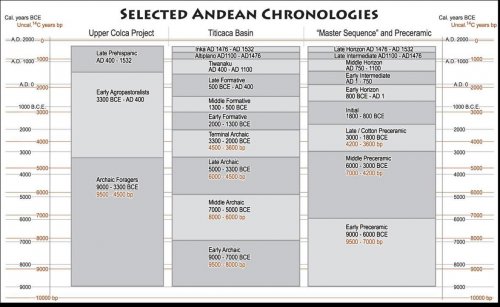Ch3 Archaeology of Region
The role of interaction across long distances has been a persistent theme in archaeological studies in the south-central Andean highlands. The emergence of the Tiwanaku state in the stark and sparsely populated altiplano seems improbable unless one considers the larger geographical setting and the apparent importance of sustained links over long distances that contributed to developments in the Lake Titicaca Basin. Archaeological research that focuses on the Formative Period, the time that preceded Tiwanaku in the Titicaca Basin, has demonstrated that regional centers coalesced out of a multitude of small villages that were articulated through a highly mobile sector of the economy based on camelid caravan transport. This chapter examines the roots of this mobile sector in the economy of the Terminal Archaic and the Formative by focusing on the transport of obsidian and the significance of early evidence of transport in the origins of long distance relationships in the south-central Andes.
This chapter will contextualized the theoretical issues surrounding raw material production and exchange in the south-central Andes. Subsequently, this chapter will explore some models of long distance interaction in the south-central Andes. Next, a review of the regional evidence for the production and circulation of Chivay obsidian from the a few major sites in the highlands will be followed by a temporal survey of Chivay distributions revealed by previous archaeological research. These regional data will be discussed by progressing through time beginning with Chivay obsidian use by early mobile foragers, and continuing in time through to the Inka period. A subsequent section considers broader patterns for use of obsidian in the Andes. This chapter concludes with a discussion of four models for obsidian procurement and circulation from the Chivay source, and the associated material correlates for these models.
A larger set of questions guides this chapter: Do the distributions of Chivay obsidian conform to those of utilitarian products like salt and dried meat, or do the distributions resemble those of prestige goods like spondylous, copper, or gold? Escaping the utilitarian / prestige goods dichotomy, a third group termed "cultural goods" better captures the traditional networks that circulated material like obsidian in the Andes. This chapter will argue that obsidian is an example of a class of material that moves between these simple classifications and that it requires a consideration of context. What pressures were responsible for the rapid change in production and circulation of obsidian during the Terminal Archaic Period? What can obsidian circulation reveal about the regional context and the strategies of early aggrandizers at the beginning of the Formative in the Titicaca Basin?
Developments in obsidian production at the Chivay source intersect with a wide swath of the Andean prehistoric sequence, and these developments will be explored below in three broad cultural periods: the "Archaic Foragers", "Early Agropastoralists", and "Late Prehispanic".
Figure 3-1. Chronologies discussed in the text.
"Archaic Foragers" are characterized as mobile foraging groups responsible for the early human use of the obsidian source, exchange, and consumption of the material. Use and exchange of obsidian by Andean mobile foragers during the Early, Middle, and Late Archaic Periods will be considered in light of ethnographic and archaeological evidence.
Next, with the domestication of camelids and chenopodium occurring sometime during the Late Archaic, food production came to dominate the economy by 3300 cal BCE heralding sweeping changes that included early social ranking that first appeared during the Terminal Archaic and early Formative Periods. During this period, referred to here as the Early Agropastoralist period, the production and exchange of obsidian appears to have changed as the material became more widely circulated in the consumption zone and mobility was facilitated by the gradual inception of regular camelid caravan transport routes. Reciprocity-based exchange systems would have coalesced, while personal procurement activities persisted from the earlier period, resulting in distinctive production evidence in the source area. The evolution of expansive states during the Middle Formative and Late Formative through to the Tiwanaku Horizon shifted the regional political structure, and these developments had repercussions in the Chivay source region. As regional centers in the Titicaca Basin emerged and began to dominate the political landscape, the established exchange patterns may have shifted to reflect the role of redistribution believed to have been occurring at the centers. Political forces became increasingly powerful in the Titicaca Basin, as well as expanding out of the site of Wari far to the north in Ayacucho, and the procurers of Chivay obsidian in the Colca area were increasingly working in a border land between powerful polities. What kinds of evidence will be reflected by the combined impacts of local provisioning, reciprocity, and elaborate redistribution systems in the Chivay area and in the Titicaca Basin consumption zone? With the collapse of Middle Horizon polities, the effects of warfare on exchange are apparent in the limited distributions of obsidian during the Late Intermediate Period. Finally, the Inka period was a time of great regional integration and tremendous redistribution of goods, but it appears that obsidian had reduced significance in favor of competing materials like metals. The changing nature of prehispanic obsidian exchange, and the link between exchange theory and the south-central Andean sequence, will be considered in this chapter.

